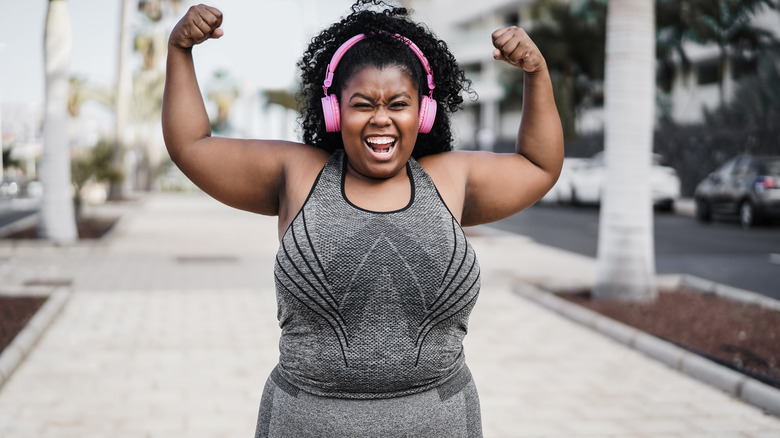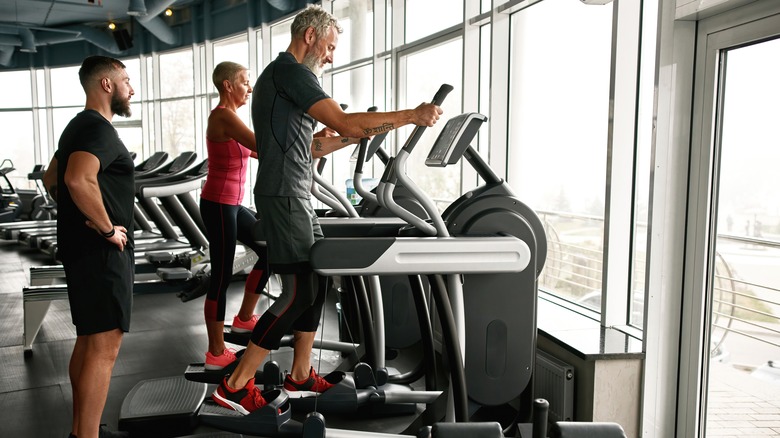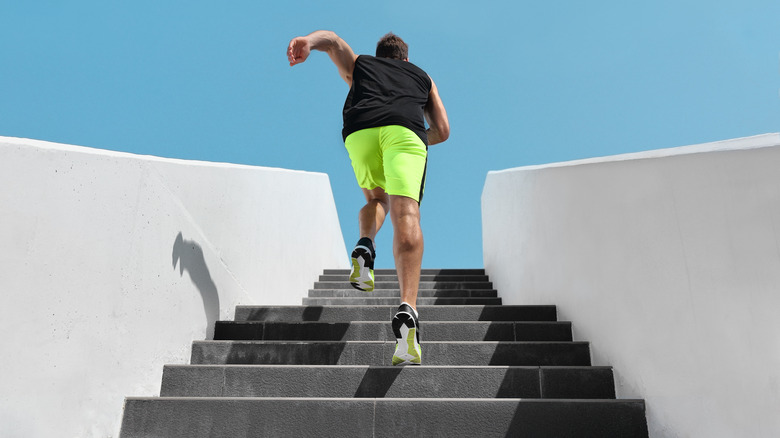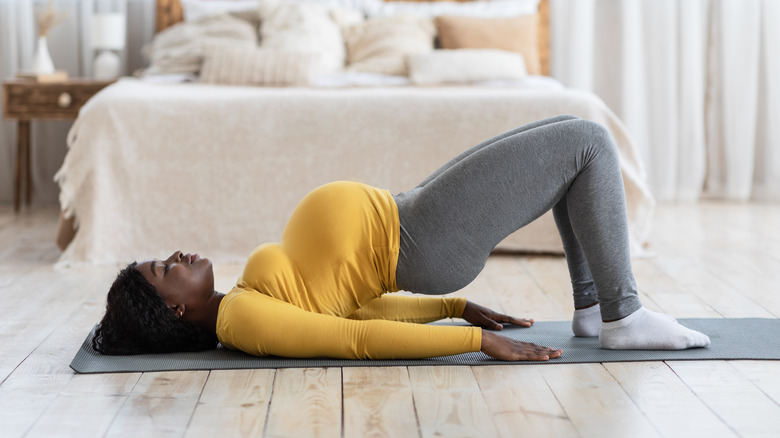Exercises That Help Balance Your Hormones
Hormones are your body's "chemical messengers," and hormone imbalance occurs when you either have not enough or too much of one or more of your body's necessary hormones, according to the Cleveland Clinic. Your body produces hormones in organs called glands, and these glands comprise your endocrine system. Examples of glands include the pancreas, which produces hormones that regulate blood sugar, and the thyroid, which produces hormones that regulate metabolism, per Healthline.
There are many different conditions associated with hormone imbalance, some of which can be life-threatening. For instance, the Cleveland Clinic says diabetes is the most common hormone-related disorder in the U.S., and it can be life-threatening if left untreated. Other conditions that relate to hormone imbalance include thyroid disease, acne, infertility, and irregular menstruation.
When you think of treating a hormonal imbalance, you may think of taking pharmaceutical drugs or herbal remedies, and these may indeed be a necessary component of your treatment depending on the condition you have. But it turns out regular exercise can also help to balance your hormones. Read on to learn about what sort of exercises can be used to treat various types of hormonal imbalances.
Regular exercise and resistance training can increase insulin sensitivity
As explained by the Centers for Disease Control and Prevention (CDC), insulin resistance is one of the primary factors that can lead to type 2 diabetes. This occurs when an excessive amount of sugar regularly enters the bloodstream, and the pancreas subsequently produces a lot of insulin to send the sugar into your body's cells for energy, but your body's cells eventually become resistant to all the insulin constantly being produced. Those with insulin resistance can have chronically high blood sugar levels because the insulin being produced by the pancreas isn't able to do its job. The CDC explains that being inactive also raises your risk of developing insulin resistance.
On the flip side, regular exercise can lower insulin resistance and increase insulin sensitivity. According to a 2015 review from Progress in Molecular Biology and Translational Science, exercise makes the pancreas (which produces insulin) much more sensitive to small changes in your blood sugar. The liver, which plays a part in metabolism and blood sugar regulation and acts as the body's filtration system, also becomes more sensitive to insulin after exercise. With regular exercise, you can help your body maintain a state where it is more sensitive to insulin. Another 2020 study from The Federation of American Societies for Experimental Biology Journal that tested resistance training in rodents found resistance training (e.g. weightlifting) could be particularly helpful in making the body more sensitive to insulin.
Moderate to high intensity cardiovascular exercise can balance the thyroid hormones
The role of the thyroid is to regulate your metabolism, as explained by the Cleveland Clinic. It produces a variety of hormones that determine your metabolic rate, i.e. the speed at which your food gets turned into energy, at any given moment. Thyroid conditions are relatively common and are often associated with an imbalance of thyroid hormones. For instance, the Cleveland Clinic says hyperthyroidism occurs when the thyroid produces more hormones than your body needs, creating an unnecessarily fast metabolism. By contrast, hypothyroidism occurs when the thyroid doesn't produce enough hormones, causing an excessively slow metabolism. Both conditions are treatable.
One way to balance your thyroid hormones is to get moderate to high-intensity exercise. A 2005 clinical trial from Neuroendocrinology Letters tested how exercises of different intensity levels affect the thyroid. In this study, 60 male athletes were instructed to ride a bicycle at three different intensity levels: low intensity, moderate intensity, and high intensity, as determined by their maximal heart rate. The researchers found that both moderate and high-intensity exercise had the most substantial impact on the thyroid hormones.
While different results might have been found among non-athletes, there's no question that routine cardiovascular exercise influences the thyroid. Another 2019 study from BMJ Open Sport & Exercise Medicine found that 16 weeks of regular moderate cardiovascular exercise caused lasting changes in thyroid function among adolescents with intellectual disabilities.
Acute cardiovascular exercise can increase endorphins
According to the Mayo Clinic, any type of cardiovascular exercise can momentarily boost the production of endorphins, sometimes called your body's "feel-good" hormones. As such, cardiovascular exercise is often recommended as a remedy for stress, anxiety, or depression, since the heightened levels of endorphins can temporarily improve your mood. This effect is sometimes known as a "runner's high," but it isn't exclusive to running. Any cardiovascular exercise, such as a vigorous walk or even dancing, can produce the same effect.
As the Cleveland Clinic explains, one of the roles of endorphins — which are produced in the pituitary gland and the hypothalamus, both located in the brain — is to provide temporary relief when your body perceives stress or pain to help you feel better. There are other ways to induce the production of endorphins in your brain, but cardiovascular exercise is one of the healthiest ways to take advantage of these "feel-good" neurotransmitters, especially because it has many other health benefits as well. It works because exercise is actually a controlled form of stress on your body, and stress causes the release of endorphins. Though it may seem counterintuitive, Harvard Health explains that exercise is actually "a form of physical stress" that can help you relax and feel better, in part because physical stress can help relieve mental stress.
Martial arts can increase oxytocin production
Another one of your body's "feel-good" hormones, oxytocin, is sometimes referred to as the "love hormone." Harvard Health explains that this is because oxytocin is boosted when we experience any positive form of physical touch, such as cuddling or sex. But this isn't the only way to boost oxytocin. Harvard Health says oxytocin can also be boosted through exercise.
In fact, martial arts (karate, taekwondo, jujitsu, etc.) have been shown to be particularly promising for raising oxytocin levels. A 2019 study from Scientific Reports tested the effects of practicing jujitsu on oxytocin production. Specifically, this study measured oxytocin levels in 68 jujitsu students of different levels (beginner to advanced) three times: before practicing jujitsu, immediately after a session, and then again after a cool-down period. The researchers found oxytocin levels were highest immediately after practicing jujitsu. The effect was the same in both beginner and advanced jujitsu students. Interestingly, the researchers found certain types of jujitsu produced even more oxytocin than others: "Ground grappling," i.e. wrestling, had a more significant impact on oxytocin levels than "punch-kick sparring." They theorize that this is because of the close physical contact associated with wrestling (since oxytocin is known to increase as a result of physical contact).
But you don't necessarily have to wrestle to feel this effect. Another 2019 study from the Balkan Medical Journal found cardiovascular exercise could increase oxytocin production in rodents.
Running can increase dopamine production
Dopamine is considered another "feel-good" hormone, in part because it acts as a "reward center," according to the Cleveland Clinic. Made by the adrenal gland and released in your brain, dopamine is crucial for many of the basic functions of your body, including learning, movement, memory, mood, the sleep-wake cycle, attention, cognition, and motivation. It is particularly important for creating feelings of motivation and reward, and when dopamine is depleted, it can be very difficult to motivate yourself. In another article, the Cleveland Clinic explains that low dopamine levels are associated with certain diseases, such as Parkinson's disease and restless legs syndrome, but dopamine depletion is also associated with feelings of exhaustion, moodiness, and feelings of depression.
There are many ways to boost dopamine, and exercise is a very healthy way to do so. In particular, running has been found to increase dopamine production. A 2013 study from NeuroReport tested the effects of treadmill exercises on patients with early-stage Parkinson's disease, which is associated with low dopamine levels. In this study, two participants did treadmill training sessions three times per week for eight weeks, while the other two did no exercise. The researchers found improved dopamine function in the participants who exercised. While this was a very small study specific to patients with Parkinson's disease, there's other evidence to suggest exercise can increase dopamine, and the Cleveland Clinic recommends engaging in any physical activity you enjoy.
Cardiovascular exercise can increase serotonin production
As Healthline explains, serotonin is involved in many processes throughout your body. Your blood, digestive system, and central nervous system are all places where serotonin is found in healthy individuals. It's involved in sleeping, healing, and regulating mood. There's some evidence that low levels of serotonin may play a part in depression. Exposure to sunlight or other bright light is known to trigger serotonin production, which may be part of the reason why low levels of sunlight in the winter can negatively affect your mood.
While light therapy can be used to boost serotonin and treat seasonal depression, cardiovascular exercise can also increase serotonin production. A 2014 study from Applied Physiology, Nutrition, and Metabolism tested the effects of 16 weeks of aerobic training (cardiovascular exercise) in 16 older men. As the researchers explain, aging is associated with a decline in serotonin transmission, so increasing serotonin production in seniors is of particular concern. The researchers found aerobic exercise led to elevated serotonin activity. The effect was most significant immediately after training and less pronounced in between training sessions, but the researchers explain that consistently exercising in this manner can help raise serotonin levels in general.
Step aerobics can increase melatonin production
Melatonin plays a crucial role in your circadian rhythm, i.e. your sleep-wake cycle. According to the National Center for Complementary and Integrative Health, your brain produces melatonin when it perceives darkness, in order to prepare you for sleep. Exposure to light at night can interfere with melatonin production and make it more difficult to sleep.
While melatonin can be taken as a supplement, there are also natural ways to increase melatonin production. A 2014 study from The Journal of Strength and Conditioning Research tested the effects of a 10-week step aerobics program in postmenopausal women with sleep issues. As with serotonin, melatonin levels tend to decrease with age, which is one of the reasons why difficulty sleeping is a common problem among seniors. The study found regular step aerobics sessions increased the production of melatonin at night and led to improved sleep quality. Additionally, another 2020 study from the International Journal of Sports and Exercise Medicine found moderate aerobic exercise could increase nighttime melatonin production in previously inactive men.
Importantly, while step aerobics and other moderate aerobic exercises can increase melatonin production at night, the exercise needs to happen during the day, as the effect is delayed. A 1997 review from the Journal of Biological Rhythms explained that nighttime exercise delays melatonin production, shifting the circadian rhythm to a later schedule.
High intensity exercise increases cortisol in the short term, but lowers it during rest
Cortisol is known as the "primary stress hormone," according to the Mayo Clinic. As we saw earlier, Harvard Health says that exercise is "a form of physical stress." This suggests that exercise can increase cortisol, but the real relationship between exercise and cortisol is more complicated.
A 2014 study from the Journal of Endocrinological Investigation that analyzed the effects of exercise of different intensity levels found that high-intensity exercise could significantly increase cortisol levels in the short term, while low-intensity exercise had a much less pronounced effect. However, it's important to understand that the effects of high-intensity exercise on cortisol in the short term are different from the long-term effects. As Healthline explains, the key is to give yourself enough time to recover in between bouts of high-intensity exercise. For instance, if you practice HIIT (high-intensity interval training), you'll need to plan rest days in between these workouts in part to make sure your cortisol levels don't remain elevated. By taking days off in between HIIT workouts and making sure to get enough sleep, you'll experience the beneficial effects of high-intensity exercise, including lower levels of stress.
Harvard Health confirms this: While exercise increases stress hormones in the short-term, regular exercise followed by appropriate periods of rest can lower stress in the long term.
Regular aerobic exercise temporarily increases adrenaline but lowers it in the long term
Adrenaline, also known as epinephrine, is another hormone associated with stress, according to the Cleveland Clinic. It plays a critical role in the "fight-or-flight" response of the sympathetic nervous system, which is the effect responsible for raising your heart rate (among other things) in response to an acute stressor. Adrenaline has other functions as well and plays a role in metabolism, focus, and excitement.
Adrenaline is known to increase during exercise, but it may decrease as a result of regular exercise in the long term. A 2020 study from The Academy of Medical Sciences of Bosnia and Herzegovina on rodents tested the effects of regular aerobic activity on adrenaline. More specifically, the rats were required to swim for 60-90 minutes every day for 21 days. Adrenaline was measured four times throughout the study: on day one, day seven, day 14, and day 21 (the last day of the experiment). Compared to the control subjects, the rats in the exercise group had higher levels of adrenaline on days seven and 14, but lower adrenaline on day 21. These results suggest regular exercise can lower adrenaline in the long term despite the acute increase during each session, similar to cortisol.
High intensity exercise can increase vasopressin levels
According to 2022 research from the National Center for Biotechnology Information, vasopressin is also known as the antidiuretic hormone and plays a crucial role in the body's fluid balance, electrolyte levels, blood pressure, and kidney function. More specifically, it reduces the frequency of urination (acting as an antidiuretic, hence its nickname) in order to maintain fluid homeostasis.
Some evidence suggests that high-intensity exercise can increase vasopressin production. A 2021 study from Metabolism Open tested the effects of high-intensity exercise on a variety of factors, including vasopressin levels. Ten adults were instructed to perform high-intensity exercise for about 40 minutes (or until they were too tired to continue) in the morning, and vasopressin was measured via blood samples before, during, and after the exercise. The researchers found a significant increase in vasopressin during the exercise.
While this can have positive effects during exercise, it's important to note that it can also lead to hyponatremia, a form of electrolyte imbalance in which sodium levels are too low. A 2017 study from Frontiers in Medicine explains that increased vasopressin during exercise can contribute to exercise-induced hyponatremia. To counter this, you may want to ensure you add electrolytes to your water after exercising, primarily salt. An article from U.S. News & World Report says exercising for more than an hour, excessive sweating during exercise, or even just feeling a bit off are all signs you should add salt to your water after exercising.
High intensity aerobic exercise can decrease estrogen and progesterone levels
As Healthline explains, estrogen and progesterone play important roles in all people, but they are considered the primary sex hormones of the female body. While estrogen is crucial for the female reproductive system, it also plays a necessary role in brain function, mood, bone growth, and health in all humans. Similarly, progesterone is used by the female body to prepare for reproduction, but it also aids appetite, immune function, cardiovascular function, and respiratory function in all bodies.
While both hormones are necessary for normal body functioning, an excess of these hormones is associated with certain types of breast cancer, according to the National Cancer Institute. In this case, exercise has been shown to balance these hormones. A 2011 study from the Journal of Applied Physiology tested the effects of aerobic exercise on hormone levels in healthy, premenopausal women with an elevated risk of developing breast cancer. Over the course of five months, participants exercised for 300 minutes per week at a high intensity. The researchers found both estrogen and progesterone levels decreased as a result of regular exercise.
Sprinting can increase testosterone
Testosterone acts as a steroid, according to the Cleveland Clinic. Testosterone levels are significantly higher in men, or people assigned male at birth, though this hormone is naturally present in everybody to some degree (as with estrogen and progesterone). Testosterone plays a role in muscle-building and libido, among other things. In people assigned male at birth, testosterone also triggers the growth of the male sex organs and other male body characteristics. In people assigned female at birth, testosterone can also enhance libido, but most of it ends up getting converted to estrogen.
Certain types of exercise have been shown to increase testosterone. A 2009 study from the Journal of Strength and Conditioning Research tested the effects of sprinting on hormone levels. In this study, 12 highly-trained handball players were asked to do four high-intensity sprints followed by short periods of rest in between (three minutes). The researchers collected blood samples before the exercise, immediately after each interval, and one hour after the exercise was finished. They found that testosterone levels had significantly increased immediately after the exercise.
Exercising during pregnancy can increase leptin and lower baby's birth weight
The primary function of the hormone leptin is to regulate appetite and body weight, according to the Cleveland Clinic. It does this by reducing feelings of hunger at times when your body has enough calories or energy. In general, accumulating body fat leads to higher levels of leptin, while losing body fat lowers levels of leptin. This makes sense — as your body loses fat, it thinks it's starving, causing it to reduce leptin in order to make you feel hungrier while gaining fat would cause your body to think it has enough energy and thus raises leptin levels. However, a variety of factors can cause the body's leptin levels to become imbalanced.
A 2010 randomized, controlled trial from Clinical Endocrinology found exercise could affect leptin levels in pregnant women. More specifically, regular exercise led to a 29% increase in leptin in the later stages of pregnancy compared to inactivity. This may seem counterintuitive — leptin reduces hunger, but exercising burns calories, which should theoretically increase hunger — but this is an oversimplification. A better way to understand the relationship is that exercise helps to regulate the overall balance of energy, which may otherwise be imbalanced. The higher levels of leptin in the exercise group were also associated with lower birth weight when the participants eventually gave birth.
Exercising too frequently, or at too high an intensity, can exacerbate hormone imbalance
As we've seen, there are a variety of ways in which different types of exercise can affect different hormones, and many of these effects are positive. The National Academy of Sports Medicine says exercise generally has a positive effect on hormonal balance.
However, as with all things, we have to be careful not to overdo it, because too much exercise can have the opposite effect. As a 2015 article from Progress in Molecular Biology and Translational Science explains, "Regrettably, an excessive intensity and/or volume of training may lead to maladaptation and is associated with inappropriate endocrine hormonal responses." In other words, exercising too frequently or at too high an intensity can cause unintended or detrimental hormonal changes.
With this in mind, it's crucial to make sure not to push yourself too hard when beginning any new physical activities or exercise regimens. As Healthline explains, too much high-intensity exercise combined with not enough rest can cause an increase in stress, which is the opposite of what we generally want to achieve with exercise. In order to make sure exercise has the intended positive effects on our hormone balance, it's essential that we take sufficient time to rest in between sessions of high-intensity activity. In between exercise sessions, Healthline recommends focusing on sleep, good hydration and nutrition, meditation and breathing exercises, massage, and avoiding additional high-intensity exercise until you're ready again.















